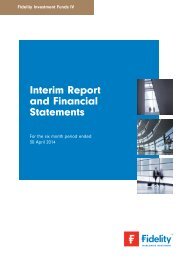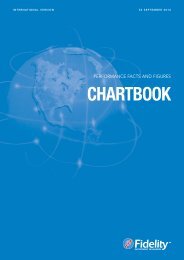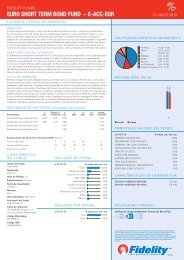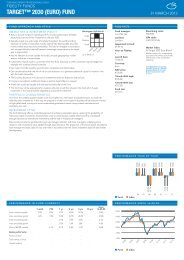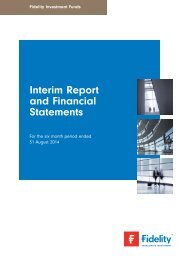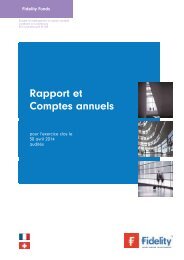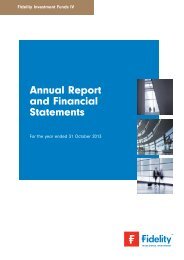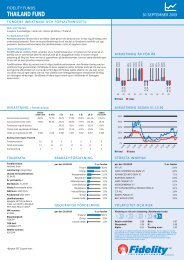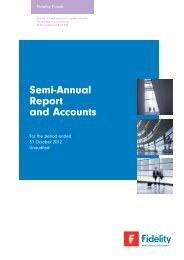fidelity funds performance - Chartbook.fid-intl.com
fidelity funds performance - Chartbook.fid-intl.com
fidelity funds performance - Chartbook.fid-intl.com
- No tags were found...
You also want an ePaper? Increase the reach of your titles
YUMPU automatically turns print PDFs into web optimized ePapers that Google loves.
EXPLANATORY NOTESThere are separate scales for Cash, Bond and Equity <strong>funds</strong> (A 1-2, B 1-3, E1-5 respectively) with ‘1’ representing the least risk. Balanced <strong>funds</strong> areincluded in the Equity <strong>funds</strong> scale. The categories reflect thecharacteristics of each asset class.In general, a fund will have a higher risk rating if we expect its returns tobe more variable. In addition, we take account of each fund’s actual andpotential exposure to factors which could have a significant impact on thefund’s returns:• Diversification (across markets or asset classes) reduces the overall risk ofa portfolio.• Funds with a small cap bias are higher risk than those with a mid capbias, which are in turn higher risk than those with a large cap bias.• Funds with a more aggressive management style have a higher relativerisk than those with a more conservative management style.• Funds invested in markets with lower liquidity (i.e. the ability to buy andsell stock in the market) are higher risk than those invested in moredeveloped, liquid markets.• Funds invested in markets with historically high volatility are higher riskthan those invested in markets with a history of lower volatility.• Funds invested in currencies with historically high volatility are higher riskthan those invested in currencies which have a history of lower volatility.The risk/return rating is intended to be a guide and only gives anindication of a fund’s risk level in relation to Fidelity’s own fund range.R2 (R-Squared): R2 is a numerical measure representing the degree towhich fund returns can be explained by benchmark returns. The R2 valueis a proportion ranging from 0.00 to 1.00. A value of 1.00 indicates that afund is perfectly correlated with its benchmark, and fluctuations in fund<strong>performance</strong> are fully explained by fluctuations in the benchmark<strong>performance</strong>. An R2 of 0.35 means that only 35% of the fund’s<strong>performance</strong> can be explained by movements in the benchmark index.Lower R2 values indicate that fund <strong>performance</strong> has more independence frombenchmark returns. If the R2 is less than 0.5 the fund’s beta is not a reliablestatistic due to the low correlation between fund and benchmark movements.Alpha: Alpha measures the fund manager’s skill in delivering <strong>performance</strong>relative to the fund’s expected return, given the fund’s market risk level asmeasured by its beta. A positive alpha indicates stronger fund<strong>performance</strong> than predicted by the fund's beta.Sharpe ratio: The Sharpe ratio measures a fund’s risk-adjusted<strong>performance</strong> for a given risk-free rate. The ratio is based on theassumption that the fund manager could invest in a risk-free asset such ascash. It is calculated by subtracting the risk-free rate of return (the officialcash interest rate of the relevant market) from the fund’s annualisedgrowth rate, and dividing the result by the fund’s volatility.The Sharpe ratio allows an investor to assess whether the fund isgenerating adequate returns for the level of risk being taken. The highera fund's Sharpe ratio, the better its risk-adjusted <strong>performance</strong> has been. Ifthe ratio is negative the fund has returned less than the risk-free amount.Volatility: Volatility measures are generally considered to be measures ofrisk; that is the more volatile the fund, the greater the risk of the investment.Volatility measures are calculated from <strong>performance</strong> over the last 3 years,and are not calculated for <strong>funds</strong> which have existed for less than 3 years.Relative volatility: This ratio <strong>com</strong>pares the standard deviation (volatility)of a fund's historical monthly <strong>performance</strong> with those of the fund’sbenchmark index. Relative volatility values greater than 1 show that fund<strong>performance</strong> has been more variable than the benchmark, whereas valuesof less than 1 show them to have been less variable.Tracking error: Tracking error is the annualised standard deviation of thedifference between the monthly returns of a fund and its benchmark. Thelower the tracking error figure, the closer the relationship between therisk/return characteristics of the <strong>funds</strong> and those of its benchmark.Beta: Beta measures the fund’s level of market risk. It calculates thesensitivity of a fund’s historic monthly returns to movements in thebenchmark index. A beta value greater than 1 indicates that fund returnswill tend to have the same sign as, but a greater magnitude than,benchmark returns, whereas a value of less than 1 indicates a lowermagnitude. Please refer to R2 for an explanation of the how R2 and betashould be considered together to assess the explanatory level of beta.6




